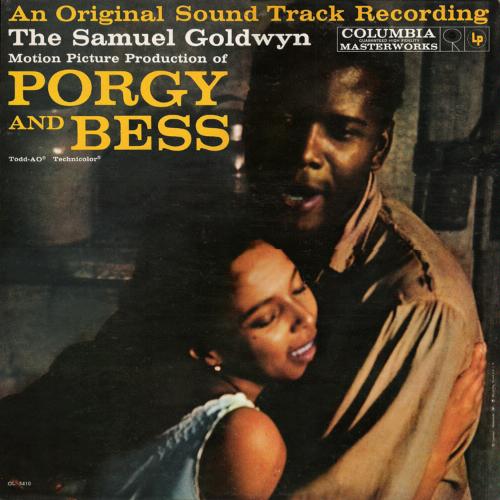American Masterpieces: Porgy and Bess at State Theatre.

Happy birthday, Porgy and Bess!
2010 marks the 75th anniversary of this landmark work and there are plenty of opportunities to catch it this year. And so you should! My opportunity was the great 75th anniversary tour, presented by Michael Capasso, at the State Theater in New Brunswick Thursday night.
Porgy and Bess (music by George Gershwin, lyrics by Ira Gershwin and DuBose Heyward, based upon Heyward’s novel Porgy) opened in 1935 in New York…on Broadway. Yes, originally Porgy and Bess ran on Broadway (for 124 performances) and it was several decades before opera companies performed the work. Today, though, OPERA America reports that Porgy and Bess was the most frequently performed North American opera of the 2008-2009 season. This spring alone, five opera companies are mounting productions (Opera Carolina, Virginia Opera, Washington National Opera, El Paso Opera and San Antonio Opera). According to OPERA America’s Schedule of Performances, since 1991, 45 opera companies have mounted productions of Porgy and Bess. Porgy and Bess occupies an important place in American cultural history, whether you consider it an opera or a musical. Or even jazz, as in the case of the 1957 recording by Ella Fitzgerald and Louis Armstrong. The first American opera company to mount a production was Houston Grand Opera in 1976, whose recording won a Grammy Award.
And, before I continue, let me answer a few questions some of you might have. Yes, Porgy and Bess is considered an opera, even though it was written in English and it was composed by an American. But like Leonard Bernstein’s Candide, it often is performed both by musical theater and opera companies.
And whether you’ve seen a stage production or not, you definitely know some of the music. The most famous song “Summertime” is a perennial favorite at American Idol auditions. But if you’re dying to hear that number, make sure to arrive at the theater on time, or you’ll miss it, since it’s the first piece of the show (as a number of the State Theater audience discovered too late). Other famous numbers include “A Woman is a Sometime Thing,” “I Got Plenty of Nuttin’” and “It Ain’t Necessarily So.”
And New Brunswick’s State Theatre is a perfect venue for Porgy and Bess. Built in 1921 for vaudeville and silent films and refurbished in 2004, the theater makes it possible to imagine that you are back in the 1930s.
The Gershwin’s Porgy and Bess was so revolutionary for its time, because it was an American work, focused on American themes and featured an entire cast of classically trained African-American vocalists.
While Porgy and Bess contains many laughter-inducing moments (the audience particularly enjoyed the banter between Clara and her husband Jake in the first scene, when they each tried to get their baby to stay asleep and Clara tried to keep Jake from playing craps), the story is a sad one. Porgy and Bess opens in Catfish Row on the waterfront of Charleston, South Carolina. Porgy is a disabled beggar and Bess is the disdained, drug-addicted girlfriend of a brutal stevedore, Crown. When Crown kills one of the men after an argument, he leaves Bess to fend for herself, but promises that he will be back for her later. All the residents of Catfish Row refuse to give her shelter, except Porgy, who takes her in. The community gradually accepts Bess, who make it clear that she is happy with Porgy and that she wants to turn her life around.
About a month later, the residents of Catfish Row are preparing for a church picnic. The local drug dealer, Sportin’ Life, appears and tries to give Bess some Happy Dust and convince her to go to New York with him. Bess refuses, Porgy chases him away and the two express their love for each other. Bess goes to the picnic without Porgy where she is approached by her old boyfriend, Crown. He prevents her from joining the rest of the picnic and traps her on the island with him.
A few days later, Bess is back with Porgy, but is sick with a fever. While she recovers, Porgy tells Bess that he knows she was with Crown. Bess says that she wants to stay with Porgy, but she’s afraid of Crown and her attraction to him. Porgy tells her that she does not have to be afraid any longer.
A few of the men of Catfish Row, including Jake, have gone out fishing to earn money, but suddenly a hurricane comes on. The women huddle together to wait for the men’s return. During the storm, Crown enters, looking for Bess. Clara runs out to the sea, to try and find her husband, Jake. Some of the men follow, including Crown, who taunts Porgy because he can’t go with them. Clara and Jake have both been killed in the storm, but Crown survives. When Crown tries to sneak in to get Bess, he gets into a fight with Porgy and is killed.
The next day, a detective questions Porgy about the death. Porgy admits to having known Crown and the detective brings him in to identify the body, which Porgy refuses to do. Porgy is jailed on contempt of court. Bess is distraught and Sportin’ Life, the drug dealer, plays on her sorrow and forces her to take some Happy Dust. She tries to resist him, but within a week, she agrees to leave Catfish Row and go to New York City with him.
In the meantime, Porgy returns home, richer for having won at craps with his cellmates. With gifts in hand, Porgy arrives at Catfish Row, looking for Bess. He soon discovers that Bess has left with Sportin’ Life for New York. Porgy then calls for his goat cart, resolving to leave Catfish Row to find her. He prays for strength and begins his long journey.
Touching on a number of social issues, including poverty, disability, race and drugs, Porgy and Bess remains a seminal American work. Seventy-five years later, not only is it still being performed, but it’s still resonating with audiences. Certainly the laughter, gasps, thunderous applause and even some tears by the audience at the State Theater on Thursday night attest to that.
Happy birthday, Porgy and Bess. Here’s to many more!





